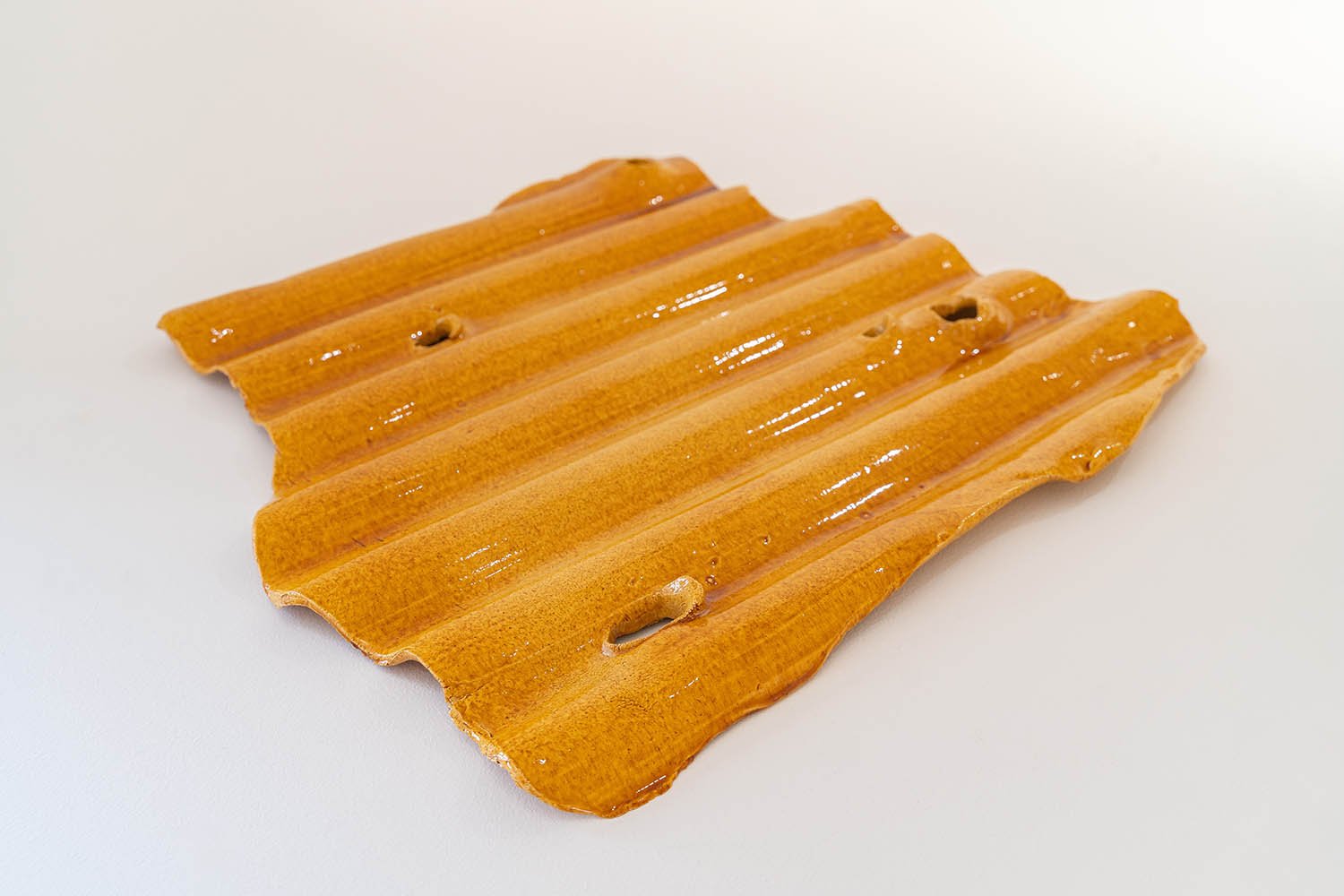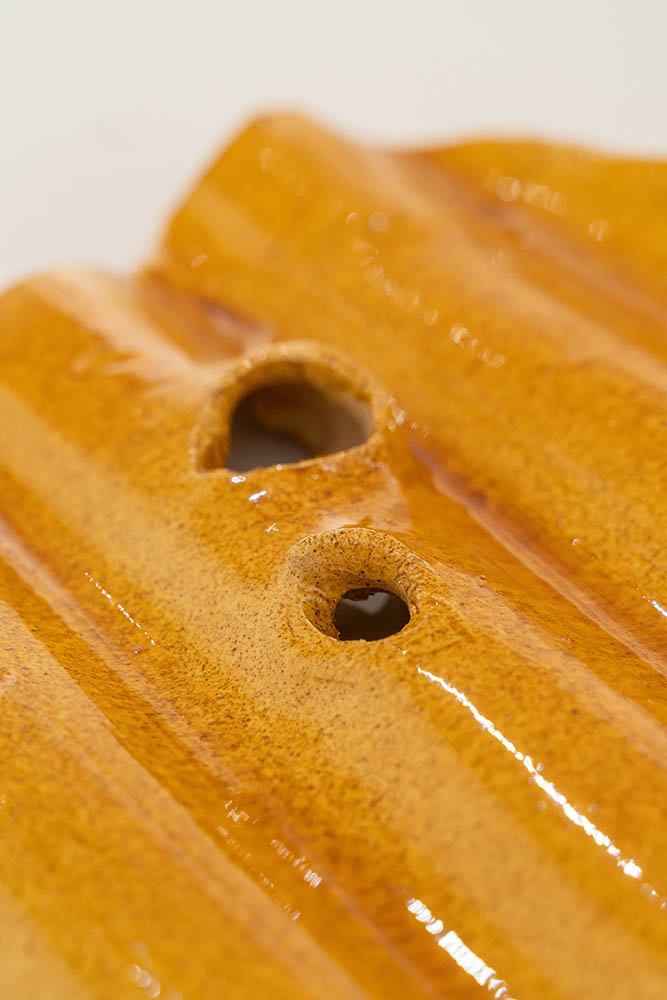FAVENTIA – 3/12. Lorenza Boisi
12.03.2024 – 11.04.2024
From March 12th, 2024, to April 11th, 2024, BUILDINGBOX hosts the artwork Ondulux (2017-2024) by the artist Lorenza Boisi (Milano, 1972).
The third event of the exhibition FAVENTIA. Contemporary Italian ceramics [Contemporary Italian Ceramics] is dedicated to the artwork Ondulux (2017-2024) composed, one might say, of colourful biographical fragments, which were made in recent years. Like old corrugated metal sheets used for temporary or semi-permanent roofing of industrial buildings, Boisi’s ceramic slabs appear to be battered, worn and fragmentary, punctured in several places, as if they were extracted from an original allocation at the end of their usefulness. The sculpture’s making was provoked by a childhood memory: a violent storm in the 1970s blew roofs off houses and warehouses, uprooted trees and caused people to despair. This events remained in the artist’s memory, in particular “because of the unexpected arrival of a vast ondulux slab of typical green, torn from who knows where, and landing on our roof garden”. By imitating the shape, modelled in the typical corrugated profile – designed in plastic or metal sheets to increase resistance to the bending stresses – Boisi fuels the visual ambiguity and arrives at the subtle contradiction between extremely different materials in terms of use and resistance. We already know about the fragility of ceramic. We know about its sentimental and domestic uses, the ancient evidencees of civilisations who, from the from the moulding of the earth, drew shapes and supports, but also decorations and images. Boisi draws, first and foremost, from factories’ production, arriving at a model, reaching a model, a solution, and a surface capable of showing as much the linearity of the design and serialised drawing as the irregularity and imperfection of a manual, uneven and non-functional making. Ceramic sculpture has been for long time at the heart of the Milanese artist’s work; her pieces reveal the immediate need to mould the material in absolute autonomy, without ever relying on the help of craftsmen.
This is an approach that is well suited for the research of expressive, existential, and emotional immediacy in painting and sculpture, where forms, narratives, mythical echoes, and objects from personal memory compose a sculptural universe with a strong “conceptual emotivity”, as the artist often states. Free gestures and bright colours that express a genuinely naïve taste along with an apparent technical skill and formal synthesis – as in the works on display, which occupy space by means of illogical arrangements and layering – reveal an innate insubordination, escaping from the supposed simulation of the object towards the invention of a body-wave that flaunts its skin glazed with new light and transparency. “The ondulux has a beautiful name: Luce ondulata [Wavy light]; yes, since it is like looking at the shallow depths, through those ripples”, the artist recalls. The specific colours of the works were made in the laboratories of the Museo Carlo Zauli in Faenza.
From January 12th, 2024, to January 11th, 2025, BUILDINGBOX presents FAVENTIA. Ceramica italiana contemporanea [Contemporary Italian Ceramics], an exhibition project curated by Roberto Lacarbonara and Gaspare Luigi Marcone, involving twelve Italian artists invited to exhibit sculptures and installations made of ceramics. This programme is dedicated to the centuries-old artistic tradition of the city of Faenza, one of Italy’s main production districts, as well as the seat and epicentre of themed projects and museums such as the “MIC International Ceramics Museum”, the “Premio Faenza”, and the “Museo Carlo Zauli”. Furthermore, the exhibition was conceived as a tribute toward an area affected by the flood of May 2023.
As with BUILDINGBOX’s usual annual schedule, the exhibition hosts monthly interventions. In this edition, the artworks will be presented on the 12th day of each month. This “numerology” alludes to the cyclical nature and synthesis of earthly, spiritual, and temporal elements, as well as the numerous symbologies associated with the number 12 in history and cultures from different parts of the world.
The project maps and summarises some of the main artistic expressions related to the 20th and 21st centuries ceramics, promoting a series of artists from different generations who, consistently or sporadically with respect to their own production, use clay working techniques by continuing, recovering, or revolutionising the extraordinary manual skill of moulding, and the chromatic-luminist value of the glazes.
The ancient Faventia has been a land of artisan production since Roman times, a characteristic that was enhanced in later centuries. Indeed, it became synonymous of the majolica ceramics in many languages – French (faïance), English (faience). In recent years, many artists have used the Faenza kilns – also thanks to residency programmes, exhibitions, workshops, prizes, and publications – for the artistic production of medium and large-scale sculptures, often designed for an environmental development and installation purposes. The primal, demiurgic act of shaping the clay gives ceramics an exclusive status, almost an ontology, the auroral condition of sculpture. In the manipulation’s plastic immediacy that precedes the firing that crystallises the piece, there is all the naturalness of a slow, thoughtful transformation poised between design and chance. In ceramics, as in drawing, there is the seed of an origin, that appears on the surface of the image and things in the precise moment of their conception. Ceramics – beyond the categorisations between craft, art, functional objects, unique, or mass-produced piece – possesses an intermediary (or intermediality) between thought and gesture, sign and sculpture, form and colour, operating, moreover, with various natural elements such as earth, water, and fire; and by hybridising artistic languages, techniques, research, and knowledge between artists and artisans.







